Andrew Veselka
 Andrew and Betsy’s 2014 REU project was “Small Mammal Responses to the Reintroduction of Gunnison’s Prairie Dog.”
Andrew and Betsy’s 2014 REU project was “Small Mammal Responses to the Reintroduction of Gunnison’s Prairie Dog.”
The prairie dog (Cynomys sp.), due to its burrowing and grazing behavior, is widely recognized as an ecosystem engineer throughout the North American grassland. Their modification and regulation of habitat affects vegetation structure and a variety of species throughout their ecosystem. In order to better understand these effects, many studies have been conducted on the responses of small mammals to the presence of prairie dogs. However, most of these have been conducted on the black-tailed prairie dog (Cynomys ludovicianus) and extrapolated to the other four species in the genus. In this study, the effects of the reintroduction of the Gunnison’s prairie dog (Cynomys gunnisoni) on the abundance and diversity small mammal populations were surveyed. Furthermore, the density of prairie dog burrow entrances was analyzed to determine whether or not there was a spatial correlation between burrow location and small mammal presence. During June of 2014 small mammals were trapped on four 16 hectare plots. Two of these plots were Gunnison’s prairie dog reintroduction sites and two were not. Additionally, traps and burrow locations were mapped to determine burrow density surrounding successful traps. The abundance of small mammals was significantly higher for several species as well as for the combined total in plots containing prairie dogs. Over twice the amount of small mammals were caught compared to the same study conducted a year before, a result possibly attributable to an increase in rainfall over the past year. The spatial analysis of burrow location was inconclusive likely because of its small sample size.
Andrew graduated in 2015 with a B.S. in Biology from Dickinson College. He currently works for the Nature Conservancy.
Ariana Ananda
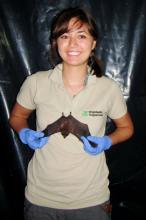 Ariana’s 2014 REU project was “Acoustic methods for sampling chiropteran diversity at the Sevilleta National Wildlife Refuge”
Ariana’s 2014 REU project was “Acoustic methods for sampling chiropteran diversity at the Sevilleta National Wildlife Refuge”
In order to assess chiropteran diversity across different habitats at the Sevilleta National Wildlife Refuge (SNWR, Socorro, New Mexico), ultrasonic echolocation signatures will be collected and analyzed with Anabat™ ultrasonic detector and Analook analysis software. A self-contained detector system will be deployed at sites chosen for habitat and management qualities. Detectors will be run for 8-10 days at each, after which call files will be downloaded. All calls will be reviewed and verified by experts to confirm species. Nunn Flats, an open Chihuahuan grassland, and Cibola Springs, a natural seep near the base of Los Pinos Mountains, are the two sites we will be monitoring. I am expecting the cohorts of species to be ecomorphologically different as high-fast flying species (such as Tadarida brasiliensis) would likely be detected at Nunn Flats, whereas species more adapted for flying in clutter or short-distances (e.g., Parastrellus, Myotis) would be likely at the natural Cibola Spring. Species that are open-foragers yet are not especially fast flying may occur at both sites in equal numbers (e.g., Antrozous pallidus). Conservation applications will be explored based on the success of drinkers attracting a wide diversity of bats. Data from a study 15 years ago will be used as a comparison for present diversity levels.
Ari graduated in 2015 with a Bachelor’s in Wildlife Conservation and Photography from UC San Diego.
Benjamin Vizzachero
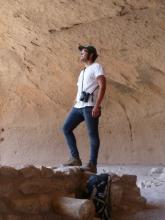 Benji and Sze Wing’s 2014 REU project was “Surveying and Nest Monitoring of the Gray Vireo (Vireo vicinior) in the Sevilleta NWR”.
Benji and Sze Wing’s 2014 REU project was “Surveying and Nest Monitoring of the Gray Vireo (Vireo vicinior) in the Sevilleta NWR”.
The Gray Vireo is a small native songbird and species of concern of which little is known. Few past studies have documented their preferred habitat, relative abundance, population size, nesting success, or the impacts of brood parasitism by the Brown-headed Cowbird (Molothrus ater). We conducted a census of the breeding Gray Vireo population within two large sample sites in the Los Piños Mountains of the Sevilleta National Wildlife Refuge. Audio playback surveys were performed across a grid of points encompassing these sites. We observed detected Gray Vireos to locate their nests and returned regularly to monitor the success of these nests. This will be the third season of data collection for this project. Study sites were selected to determine if distance from rangeland affects rates of brood parasitism, though it seems differences in landscape are more influential on cowbird abundance. By quantifying the abundance and nesting success of the Gray Vireo, we can determine their population status and potential need for conservation action. Documenting the vegetation around nest sites will create a snapshot of the ideal Gray Vireo nesting habitat, which could be incorporated into future habitat management plans across their range. Overall, we found 19 Gray Vireo nests, of which 7 successfully fledged Gray Vireos, 4 were parasitized by cowbirds, and 8 failed for other reasons.
Benji graduated in 2016 with his B.S. in Wildlife and Fisheries Science from Penn State. He is currently in graduate school pursuing a Master’s degree.
Cassandra Miller
 Cassie’s 2014 REU Project was “Natural and artificial desert spring ecosystems influence on aquatic macroinvertebrate communities in semi-arid New Mexico.”
Cassie’s 2014 REU Project was “Natural and artificial desert spring ecosystems influence on aquatic macroinvertebrate communities in semi-arid New Mexico.”
In arid and semi-arid environments, springs are oftentimes the only stable source of water. Aquatic macroinvertebrates play a large role in the maintenance of these ecosystems. Thus they have a bottom-up influence on the larger ecosystem. This study surveys and compares the aquatic macroinvertebrate community composition in natural and artificial springs on the Sevilleta National Wildlife Refuge. Natural springs had a higher abundance, and a significantly higher richness in comparison to communities in artificial springs. I propose that future conservation efforts should focus on the maintenance of natural springs environments.
Cassie graduated in 2016 with a B.S. in Biology from Grinnell College. She is currently working as a fellow in Namibia at the Gobabeb Research and Training Centre.
Dorothy Stearns
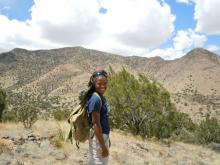 Dottie’s 2014 REU project was “Drought Exposure in EDGE Plots and Root Productivity in Blue and Black Grama”
Dottie’s 2014 REU project was “Drought Exposure in EDGE Plots and Root Productivity in Blue and Black Grama”
Alterations in temperature, precipitation and more frequent and severe periods of climatic extremes affect plant growth and productivity. These alterations, implemented from the Extreme Drought in Grassland Experiment (EDGE) at the Sevilleta Wildlife LTER, will be used to conduct research of root productivity in Blue Grama (Bouteloua gracilis) and Black Grama (Bouteloua eriopoda) located in the experimental, destructive sampling plots. This is significant because root systems are very important for carbon storage, soil quality, plant health, and success of seeding plants. Using EDGE, root productivity will be measured under various drought conditions in the Chihuahuan Desert and Shortgrass Prairie ecosystem. These conditions include a reduction of 66% of annual rainfall, no rainfall, ambient rainfall (meaning no experimental change in rainfall), and seasonal changes in rainfall exposure. In the upper 4 inches of the soil surface, we plan to investigate the root quality in terms of size, distribution, and mass of the root system in this project. 240 root biomass samples will be collected from root ingrowth bags and measured for carbon and nitrogen content from the two sites. By addressing the question does root productivity in desert grasses varying depending on drought conditions, we can observe plant sensitivity and resilience to specific drought conditions caused by water stress. The mechanisms underlying these patterns of ecosystem sensitivity, specifically root resilience and productivity, will be explored at both the site and regional scales with a novel integrated experimen tmodeling (EM) framework that explicitly couples an ecosystem process model and a multisite climate change experiment using a data assimilation approach.
Dottie graduated in 2015 with a B.S. in Environmental Science from Emory. She is currently a Master’s student at Emory in Environmental Health.
Elizabeth Black
 Betsy and Andrew’s 2014 REU project was “Small Mammal Responses to the Reintroduction of Gunnison’s Prairie Dog.”
Betsy and Andrew’s 2014 REU project was “Small Mammal Responses to the Reintroduction of Gunnison’s Prairie Dog.”
The prairie dog (Cynomys sp.), due to its burrowing and grazing behavior, is widely recognized as an ecosystem engineer throughout the North American grassland. Their modification and regulation of habitat affects vegetation structure and a variety of species throughout their ecosystem. In order to better understand these effects, many studies have been conducted on the responses of small mammals to the presence of prairie dogs. However, most of these have been conducted on the black-tailed prairie dog (Cynomys ludovicianus) and extrapolated to the other four species in the genus. In this study, the effects of the reintroduction of the Gunnison’s prairie dog (Cynomys gunnisoni) on the abundance and diversity small mammal populations were surveyed. Furthermore, the density of prairie dog burrow entrances was analyzed to determine whether or not there was a spatial correlation between burrow location and small mammal presence. During June of 2014 small mammals were trapped on four 16 hectare plots. Two of these plots were Gunnison’s prairie dog reintroduction sites and two were not. Additionally, traps and burrow locations were mapped to determine burrow density surrounding successful traps. The abundance of small mammals was significantly higher for several species as well as for the combined total in plots containing prairie dogs. Over twice the amount of small mammals were caught compared to the same study conducted a year before, a result possibly attributable to an increase in rainfall over the past year. The spatial analysis of burrow location was inconclusive likely because of its small sample size.
Betsy graduated in 2016 with her B.S. in Biology at the University of Massachusetts. She is currently a research assistant for Dr. Alex Gersom.
Emily Kottler
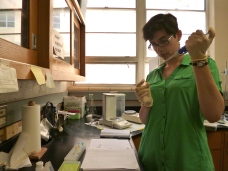 Emily’s 2014 REU project was “Population genetics of Salix exigua in the Middle Rio Grande.”
Emily’s 2014 REU project was “Population genetics of Salix exigua in the Middle Rio Grande.”
Hydrochory, or the dispersal of seeds and other propagules via water, is one of the primary dispersal mechanisms of many riparian plant species. It allows gene flow from upstream to downstream populations, shaping genetic structure.Water-mediated dispersal may increase genetic diversity in floodplains, but rapidly spreading hydrochorous plants can also decrease biodiversity by forming monocoltures. Salix exigua, or coyote willow, is a plant native to western North America found in riparian ecosystems, which can be prolific at colonizing riverbank areas due to its diverse dispersal modes and ability to reproduce sexually and clonally. Although important as a stabilizer of stream bank areas, S. exigua can act as an aggressive colonizer that overcrowds streams which can choke water flow. This population study examines the genetic structure of S. exigua populations in the riparian ecosystems that surround the Middle Rio Grande to assess how this potentially invasive native plant migrates across the landscape. I sampled S. exigua populations at 8 sites on the Sevilleta National Wildlife Refuge along both the Rio Grande and an artificial drain extension that runs adjacent to it. I then use inter-sequence simple repeats (ISSR) as molecular markers to detect genetic variation at four loci among and between willow populations. I predict that hydrochory plays an important role in gene flow for S. exigua. If that is the case, we should see strong genetic differentiation between populations on different waterways as well as increased intra-population diversity in downstream populations. Preliminary results found high genetic differentiation between populations, and also high within population variance. This project will continue after the REU internship is completed, in order to complete our data set with the goal of publishing in a scientific journal.
Emily graduate in 2016 with a B.A. in Biology from Vassar College. She is currently a Conservation Intern at Conservation Land Management in New York.
Janet Garica
 Janet’s 2014 REU project was “The effects of sediment disturbance on macroinvertebrate communities at the confluence of the Rio Grande and Rio Salado.”
Janet’s 2014 REU project was “The effects of sediment disturbance on macroinvertebrate communities at the confluence of the Rio Grande and Rio Salado.”
Unlike the sandy composition of the Rio Grande’s streambed, one of its tributaries, the Rio Salado, has a mixture of varying sizes of sediments. These then get deposited into the Rio Grande, creating a confluence area of the two streams. In addition to sand, there is gravel and cobbles mixed in. The confluence creates a heterogeneous habitat for benthic macroinvertebrate communities. This naturally attracts high diversity of macroinvertebrates because there are various niches to be filled. However, as sediment is disturbed by flow, so are the macroinvertebrate communities. My hypothesis is that there will be less macroinvertebrate diversity in areas of high sediment disturbance, since these are not stable areas for food sources or shelter. To test this, I had three project sites that were along the confluence. One was upper-confluence, the second at the confluence, and the last was downstream. At these sites I collected four sediment samples from each. These were dried, painted, and placed in baskets to be positioned back in the river at the same location from which they were taken. After 24 hours the baskets will be collected. We will assess sediment disturbance by measuring the proportion of painted sediment that left the basket and the new (un-painted) sediments that entered the basket. However, due to river water levels, the sediment disturbance experiment was performed artificially. In addition to observing the sediment disturbance, a 1 cm core sample of the sediment was taken to analyze the diversity of aquatic macroinvertebrate communities and another set to measure periphyton. My results supported that the site with the overall highest taxa diversity was the downstream site and there was no significant difference between the sites when looking at the biotic index. There appeared to be a trend in the chlorophyll a amounts which suggested that the downstream site had the most and there was no apparent trend for sediment lost. We conclude that there is a correlation between the type of test site and the taxa diversity richness.
Janet graduated in 2015 with a B.S. in Biology from California State University, Channel Islands. She currently works as an Education Intern at US Fish and Wildlife.
Jarildy Javier
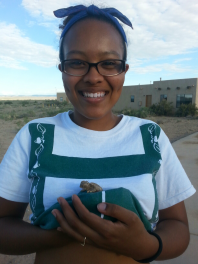 Jari’s 2014 REU project was “Prairie dogs and herps: How the age of a prairie dog town affects the herpetofaunal population.”
Jari’s 2014 REU project was “Prairie dogs and herps: How the age of a prairie dog town affects the herpetofaunal population.”
There is growing concern over the prairie dog, said ecosystem engineer, for they have been declining steadily due to many prairie dog eradication programs. Research suggests that the prairie dog, like the Gunnison’s prairie dog (Cynomys gunnisoni), plays in important role in grassland ecosystems, being referred to as a keystone species in those areas. We used the Sevilleta National Wildlife Refuge’s Gunnison’s prairie dog reintroduction program as a means of analyzing the effect of the age of prairie dog town on the population and species diversity of herpetofauna in the area. Standardized visual encounter surveys were conducted to measure species richness and estimate relative abundance from June to July. Three 400m x 400m plots were studied one with a 4 year old prairie dog population, one with a two year old population and one control plot. High diversity and abundance were positively associated with increasing age of the prairie dog town. The lesser earless lizard (Holbrookia maculata) was very strongly correlated with prairie dog mounds where it was found over 75% of the time overall.
Jari graduated in 2016 with a B.A. in Biology from Colby College.
Jennifer Sparks
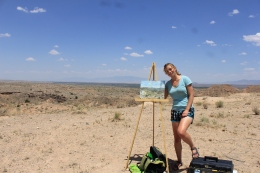 Jennifer’s 2014 REU art project was “Mesa view over time.”
Jennifer’s 2014 REU art project was “Mesa view over time.”
A stop motion animation is created by stringing together many still images, each with slight changes, together to make a moving scene. When done out in the field, this process picks up changes that are not only intentional by the artist, but also changes that are inherent to the landscape- the change in light and weather, vegetation, topography. I created a site-specific combination of stop-motion animation and time-lapse photography with the intention of it serving as a representation of my coming to understand the landscape. It reveals an appreciation for grand views, a curiosity in the geology and a slow process of getting to know the trail more thoroughly and on different levels. Through the process of making this piece, I got to experience the trail at many different times of day, over the course of several weeks and in different weather conditions. Mesa View Over Time is an attempt to represent the landscape in such a way that feels more true to the evolving series of experiences that a landscape really is. To me, a landscape is a series of full experiences and Mesa View Over Time is an attempt at representing this depth.
Jenny graduated in 2015 with a Bachelor’s in Geology from Brown University and a Bachelor’s in Sculpture from Rhode Island School of Design. Jenny currently works as the Community Relations Manager at the Steel Yard.
Lauren Merchant
 Lauren’s 2014 REU project was “Floral polychromism in Sphaeralcea polychroma.”
Lauren’s 2014 REU project was “Floral polychromism in Sphaeralcea polychroma.”
The species of Sphaeralcea polychroma that persists on the Sevilleta National Wildlife Refuge is the only species in its genus that has different colored flowers in the same species and in the same population. The goal of this study was to better understand the mechanisms, causes, and consequences of how this level of polychromism is maintained within the population. Pollinators are a likely candidate, but soil properties and other factors may contribute on a larger spatial scale. Frequencies of flower colors in each population were recorded and color ratios of the populations calculated. This involved collecting up to 5 flowers from each individual for spectral analysis back in the lab. For the subset of populations near meteorological stations, we tested whether color frequencies correlated with environmental data (rainfall, temperature, etc.). We also examined whether color frequencies correlate with simple observations of soil properties (e.g. texture, parent material, compaction, microbes, humidity, etc.). Pollinator visitation will be observed and recorded during flowering and we will conduct these observations at existing adult plants to determine frequencies of visitation by various insect pollinator species. Focal plants were selected from one of our chosen populations. Vouchers of the insects (5 per species) were preserved for long term storage. In addition to the naturally occurring plants examined above, we also used potted Sphaeralcea polychroma individuals from the greenhouse temporarily to the field to examine pollinator visitation to the potted plants. These individuals were native genotypes to the Refuge. Hopefully this research will help to understand how levels of diversity can be maintained at such a small spatial scale. This will also provide the refuge with long-term data on their populations of S. polychroma.
Lauren graduated in 2016 with a B.S. in Biology from St. Louis University.
Morgan Matthew
 Morgan’s 2014 REU project was “Layercake: Exploring the aesthetic and material landscape of the Sevilleta National Wildlife Refuge.”
Morgan’s 2014 REU project was “Layercake: Exploring the aesthetic and material landscape of the Sevilleta National Wildlife Refuge.”
Growing up in the wild landscapes of the western United States has strongly influenced my artistic practice. The contrast between the pristine and the permanently altered landscape in this region strongly influences my work. I strive to create work that illustrates the “less glamorous” sites of the western United States (areas of resource extraction, ecological engineering projects, etc.) because they are the reason why we have protected sites like the Sevilleta National Wildlife Refuge and the myriad of other public lands across the West. To promote more sustainable artistic practices within my own work, I harvest and process my own ceramic materials. This allows me to disengage myself from the large scale strip mining that must occur in order to create commercial (store-bought) ceramic materials like clays and glazes. The significant amount of time and effort needed to create my artwork has helped me better appreciate my materials as both an artist and geologist.I strive to create ceramic artwork that utilizes drawing and sculpting techniques as tools to illustrate the landscapes from which my ceramic materials have come from.
Morgan graduated in 2014 with a B.F.A. in Fine Arts from the University of New Mexico.
Reynelda Piaso
 Reynelda’s 2014 REU project was “Changes in vegetation growth over twenty years in mixed grass ecotones at the Sevilleta NWR.”
Reynelda’s 2014 REU project was “Changes in vegetation growth over twenty years in mixed grass ecotones at the Sevilleta NWR.”
The project objectives were to observe grassland changes on two study sites at Sevilleta National Wildlife Refuge (NWR) over twelve years. The study used historical photos, current photos and characterization of the study plots with special interest in blue grama (Bouteloua gracilis) and black grama (Bouteloua eriopoda) grasses. There were two parts to the project. Part one of the project used characterization maps to understand the effect climate has had on the two sites. Part two of the project used photos from 1992 and 2014 to quantify the movement or growth of individual plants between those years. This project looked at six 300m x 300m macro plots located at a long-term burn study and a long-term grazing study on the Sevilleta NWR. Each macro plot has twelve 3mx4m permanently located subplots. The two sites are located on separate ends of the grasslands on the refure, making them about seven miles apart. Characterizations of the sites included: vegetation cover, soil type, temperature and precipitation. These characterizations provided a better understanding of the pressures climate change has had on these Chihuahuan desert grasslands and will provide an explanation of growth/ decline and movement of the blue grama and black grama. Not only did the project look at historical and present data, future predictions were looked at as well. This project looked at the National Center for Atmospheric Research (NCAR) 2050 and 2099 Predictions for Worst Case Scenario.
Shane graduated in 2015 with a A.S. in Geospatial Information Technology from Southwestern Indian Polytechnic Institute. She is currently an undergraduate student at the University of New Mexico.
Roy Moger-Reischer
 Roy’s 2014 REU project was “Bouteloua grasses, soil type, moisture, and crust cyanobacteria interact in Chihuahuan desert grassland.”
Roy’s 2014 REU project was “Bouteloua grasses, soil type, moisture, and crust cyanobacteria interact in Chihuahuan desert grassland.”
Biological soil crusts (BSCs) are microbiotic communities of lichens, mosses, and cyanobacteria that create a living crust in the interstices amid vascular plants in xeric ecosystems. They are known to affect numerous soil properties and experience positive and negative interactions with local vascular plants. However, the pathways to these plant-BSC microbe interactions are largely unexplored. In order to investigate associations of plant species identity, cyanobacteria density in circumambient BSC, and local soil type, we gathered crust material and soil near focal plants of two species (Bouteloua eriopoda (BOER) and B. gracilis (BOGR)). We assessed crust chlorophyll content, both in dry conditions and after rain, as a proxy for cyanobacteria density. Several abiotic soil metrics were assessed as well. Crust cyanobacteria were distributed randomly with respect to plant species and soil type. Chlorophyll density decreased after rain. BOER and BOGR inhabited distinctly different soil type patches. The findings of the study inform implications of continued climate change for the Chihuahuan Desert grassland.
Roy graduated in 2016 with his B.S. in Ecology and Evolutionary Biology from the University of Rochester. He is currently a graduate student at Indiana University.
Sze Wing Yu
 Sze Wing and Benji’s 2014 REU project was “Surveying and Nest Monitoring of the Gray Vireo (Vireo vicinior) in the Sevilleta NWR”.
Sze Wing and Benji’s 2014 REU project was “Surveying and Nest Monitoring of the Gray Vireo (Vireo vicinior) in the Sevilleta NWR”.
The Gray Vireo is a small native songbird and species of concern of which little is known. Few past studies have documented their preferred habitat, relative abundance, population size, nesting success, or the impacts of brood parasitism by the Brown-headed Cowbird (Molothrus ater). We conducted a census of the breeding Gray Vireo population within two large sample sites in the Los Piños Mountains of the Sevilleta National Wildlife Refuge. Audio playback surveys were performed across a grid of points encompassing these sites. We observed detected Gray Vireos to locate their nests and returned regularly to monitor the success of these nests. This will be the third season of data collection for this project. Study sites were selected to determine if distance from rangeland affects rates of brood parasitism, though it seems differences in landscape are more influential on cowbird abundance. By quantifying the abundance and nesting success of the Gray Vireo, we can determine their population status and potential need for conservation action. Documenting the vegetation around nest sites will create a snapshot of the ideal Gray Vireo nesting habitat, which could be incorporated into future habitat management plans across their range. Overall, we found 19 Gray Vireo nests, of which 7 successfully fledged Gray Vireos, 4 were parasitized by cowbirds, and 8 failed for other reasons.
Sze Wing graduated with her B.S. from the University of Maryland, College Park in 2015. She is currently an Environmental Educator.
Wendy Flores
 Wendy’s 2014 REU project was “Understanding the social behavior, distribution and population dynamics of Gunninson’s prairie dogs at Sevilleta NWR.”
Wendy’s 2014 REU project was “Understanding the social behavior, distribution and population dynamics of Gunninson’s prairie dogs at Sevilleta NWR.”
Restoration of the Gunnison’s Prairie Dog into unoccupied land has been done through translocations in the Sevilleta National Wildlife Refuge. Survival of these introduced species usually depends on how they adapted to their habitat in the first few weeks after translocation. In this study, we first observed the behavior of prairie dogs already established on Plot B, a chosen area in the refuge with a community of prairie dogs, and captured these individuals to mark them using hair dye and obtain a rough estimate of the population. Radio Collars were placed on new individuals translocated from urban areas to track their dispersal in their new habitat. These prairie dogs were first released into acclimation bins (soft release) for 10 days and then released into the same plot with the already established prairie dogs. We observed the behavior of both groups interacting together and with the resources in Plot B. Using a GPS system, we spatially mapped burrow systems to understand the expansion of colonies. We predict that the newly established prairie dogs will remain close together, and establish their colony into areas where there are few other colonies. This study will be able to aid wildlife management here at the refuge, and further explore the efficiency of translocations as a method for conservation.
Wendy graduated in 2015 with a B.A. in Biology from Rutgers University. She is currently a Master’s student at Columbia in Conservation Biology.